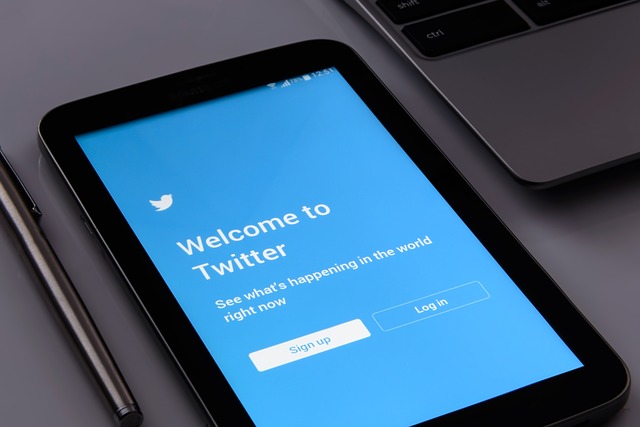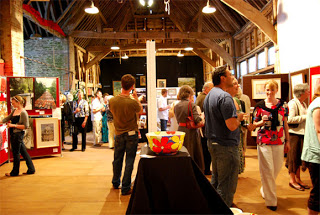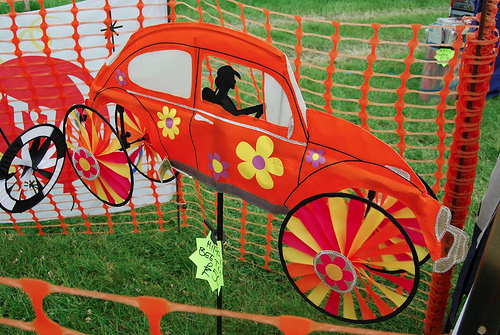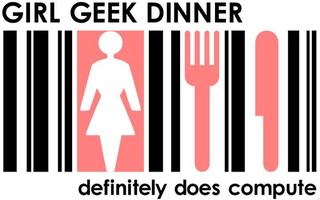DIGITAL
-
Pinterest for fundraising – case study
We have talked about collaboration during February Social Media Week in London so here is a great case study how a new social media tool combined with a little bit of it can support fundraising activities. I say “support” because I personally think that it’s good to have a good mix of various fundraising methods and not to rely on just one method and one social media avenue.
As Pinterest becomes more and more popular we start to see nonprofits on it but now also quite good case studies of particular fundraising activities. 10 Minute Teabreak is basically a collaborative board of pins (bookmarked visuals) related to the topic of the tea party:
Friday 2 March 2012 is 10 Minute Teabreak day. Have a cuppa with friends, family or colleagues and get them to pay for their tea, coffee and cake for Quarriers! Feel free to add your pins of cake, tea and coffee related photos! Don’t have time for a Teabreak? Text ‘BREW10 £1’ to 70070 – you’ll be helping some of the most vulnerable people in society.
I found myself in it simply added by a friend and as a coffee blogger, I obviously had a bit of material to add. Call it a classic example of clicktivism yet by adding my personal photos to the board according to the current Pinterest copyrights I am allowing the charity to use them for fundraising activities.
Simple, well executed and actually quite fun! As a contributor, I get to connect with people dedicated to the cause and to the topic – which is, of course, a bonus! I really like this one!
-
Barcamp Nonprofits London write up
I am really sad to see the Barcamp Nonprofits London finished. It was a bit of a hectic process to organise it but I think it went really well – due to the great support of Amy, Laila, Nick and other organisers on the way; thanks to great support of my bosses – Euan and David from @nfpvoice but also because of the great response from all our attendees. And big thank you to our sponsors:
The Prince’s Foundation for Building Community, Voice and The Phone Room, UK Fundraising, JustGiving, Moo, Rapidata Services, Eventbrite, Blackbaud and The Browser.
When I said to my boyfriend that I am a bit worried about this event he wondered why – as a geek why would you worry about a barcamp? There is nothing that can go wrong during a crowd-sourced conference. However running an event for an audience new to the format is not something that one can predict or assume as a success. I was trying to stress that the success of this one depends on each and every person but really – you have to attend a barcamp to understand its rules. So today I need to sum up my feelings and initial thoughts about the day somehow. Luckily I am not the first one to do it. We have Laila, Louise and James posting about it already, so I can base my point on their words too. My take is obviously more focused on the organising and goal of the event than sessions themselves though I have promised myself that during the next barcamp I will attend more sessions and stay in those longer.What I did like this time content-wise was:1. The session on how kids use Internet run by @phazoneverload – we will follow it up with collaboration, maybe on our Barcamp Kids in Tech in Oxford this fall. The fact that we had a 14-year-old attendee standing up in front of us making the point on young people currently being on-line and really not respected for it speaks for itself. I have been recently highly disappointed in my work with primary schools on safe Internet practice so this session was the answer to my prayers. This feeling when you start giving up and you see the spar of inspirations. Additionally, I would like to point out that the idea of naming the session in a way which raised everyone’s interest was brilliant!:)2. The session on on-line privacy run by Shaun over Skype from Washington D.C. – I still cannot believe how he managed to run through all major areas of on-line privacy with a special focus on the not-for-profit sector within 30 minutes answering our questions in the meantime!3. The session on Global Voices Online – I was really happy to see the questions and relevance of this topic to the event – I was not sure if citizen journalism will find its audience, yet it did!4. Google+ Hangout (recording here) – I know it generated various responses (some people felt that the excitement of speakers and strong love for G+ was a bit overwhelming and not always relevant) but I am really happy to see that those who wanted to benefit from the session actually did. We see a hangout planned already and I hope that many charities will at least start experimenting with it. I also hope that some of the attendees will make the most of the fact that they were connected with the format’s specialists for future support – they are really nice and will help if needed! 🙂5. Panel discussion for Social Media Week – raised some really important issues and for me personally was an eye opener. People whom I usually see confident on topics related to social media for the sector seemed a bit inconsistent on the day, people who usually do not speak up much and get on with the work suddenly really made a huge impression on me – I am really inspired by their points. For few of us there it was also a bonding experience, which is a treasure!Sessions I missed out on AudioBoo, video content creation, fundraising on-line and much more – I so wish I was there! In terms of the event itself, I think we will need to wait for more feedback but I do agree with all the points made already and I am starting to work with the organisers of the next event – bigger, longer and louder one! So if you want to get involved, please let me know! -
Barcamp Nonprofits London in just one week!
Barcamp Nonprofits is in just one week and it looks like we are ready to provide our 100 attendees with space and tools to collaborate, network and brainstorm. I would like to say big, big thank you to Euan Semple and David Dixon for support, Steve Bridger and Howard Lake for ideas and all the support as well. A big hug goes to Amy, Anna, Laila, Lesley, Nick and Krzysztof for helping me in organising of this event. I will also mention sponsors quite a few times on the way!;)
So, what do you need to know before next Friday? Here it is:
Plans for the day:
We will be meeting with the organisers really early in the morning to finalise the goodie bags, plan for the day and to set up the venue. At 9.30 we will open the registration.
Around 10 AM we will open the event. We will explain how the day looks like and start planning the sessions. You will be offered small post-it’s and pens to write down your topics, ideas for the session and asked to place them on the schedule. We will place the schedule in a central location so you can refer to it during the day or make changes and additions if you wish to do so.
At 10.30 we have a small G+ hangout with our friends from all around the world. Of course, this is only initial plan, we will see how the day goes. It all depends on our attendees of course. For lunch we will be going out to come back for afternoon sessions, virtual chat on online privacy at 3ish and Social Media Week panel at 4 PM. We are hoping to wrap it all up by 5.30PM and finish the day with a drink in one of the local pubs.
How to prepare for the event?
It really depends on what you want to get out of it yourself:
1. Bring your current projects and interests, start a discussion about those, run a session to share experiences with other barcampers.
2. Blog, tweet, take photos and record videos – the more you help us document the event, the better chance we have to follow this barcamp up with an even larger one next year! (yes, we are already planning the next one;))
3. Say thank you to our sponsors. For us, organisers, the event itself is going to be a great reward, but there were quite a few people on the way who trusted us entirely and we would love you to join us in mentioning them at least once on-line to say thanks.
4. Be open to contribute to all aspects of the event – we might ask you to help us with a snack or making coffee, we might need help with cleaning up, we might need you to moderate a session if one group of people is stuck with their discussion. You do not need to prepare for this, just come with an open mind and willingness to take active part in our event.
Sounds simple but trust me – if you are used to conferences and have never been to a barcamp before it will be a new experience. I have talked to few attendees already and it looks like the idea of not having to prepare and move away from listening to active participation might be a new thing. If it is, let us know and we will guide you through the process.
The main idea is trust and responsibility for your own attendance – Barcamp Nonprofits is yours and you will have to figure out on the day how to make the most of it.
Practical Information:
1. We will only have wifi for our event bloggers due to the local network restrictions so please bring your own wifi, mifi, 3G on your mobile etc. The venue is fairly central and we have tested few major 3G providers – you should be ok to tweet and blog from your mobile devices and mifi connections. If for any reason you do not want to be featured in photos and other online materials you will need to tell us at the registration.
2. Food – we are providing you with coffee, tea and snacks. We do not have a sponsor for lunch this time so the organisers will suggest few local venues and lunch time sessions where you can join them, have a chat and grab some food yourself. This is our first event in London and we hope that is we have enough word of mouth and recommendations we will be able to find a sponsor for lunch for you during our next event. We have heard the gossip that Prince’s Charities are preparing a cake bake-off for us, so who knows maybe we will have an excuse to have sweets for lunch!
3. Dress code is casual, we want you to relax and feel comfortable. Barcamps were originally coding events running for few days, not conferences requiring a suit;)
4. Representing your organisation – I have posted about it already, but I would like to remind all attendees (and I will do so on the day too) not to use this event as purely opportunity to drive more business or recruit free resources to your projects. Unlike conferences, social innovation camps or hacking events dedicated to specific solutions barcamp is a series of collaborative sessions around particular problems and topics, not a place for a pitch. If you want to promote your company or organisation you have the option to contribute to our goodie bags (100 of them;)). I am going to be very careful about this because I want to ensure good atmosphere at the event, so please respect that. This point will affect the way we run future events too.
5. Suggesting your ideas – we are open to all suggestions. Do you want to run a workshop or a networking activity? One of our co-organizers had a great idea to engage attendees in games and team building exercises – which might be good for some of you, others might want to skip it. It’s fine! Maybe you have done something similar in your organisation and would like to share it with us? Bring those ideas with you!
6. Connect – we have created a Facebook Group , Twitter list, LinkedIn event and Layrd event for you. Connect with others through those spaces and through the event hashtag #barcampnfp.
7 days to go! I cannot wait to see you all there!:) Have a great weekend!
-
The story of Africa
I am sure I am not the first person to say this – actually I am writing this in response to @ifundraiser’s recent post about how we approach Africa in fundraising activities, in response to the recent ActionAid UK’s bloggers tea party I attended and to something my son said few times. You see I am not an experienced fundraiser – I would never dare to say that. I have started actively working in social media for this sector a few years ago, and even for personal projects, I have only used it for few years. I do know however that in all our work we do and project online the story really matters – not because it is fiction, but because most of the stories we tell ARE reflecting our reality. With the rise and huge development of social media over the last few years, the idea of the postmodernist story in a story and play between fiction and reality has resulted in a great self-regulating notion of trust – trust in what we say, who is saying it and what the meaning of our conversation really stands for.
Yet, I am genuinely upset about the current narrative surrounding Africa and fundraising activities run in the African region. The notion of guilt in all major charity campaigns in the UK in support of African countries does not work for me – and as this recent study shows that I am not the only one. When it comes to my personal choices in supporting charities I based them on a complex set of variables (personal experiences, current social media competence and skills of charity’s team, transparency and engagement in actual work in the field, understanding of how my money actually helps people at the end of this really complicated process). I have to honestly admit that most of the time I donate to causes where stories are told from many angles, in multiple directions and at the end of the day is relevant to me. Just as much as I have become more aware consumer of commercial brands I expect charities and fundraisers to tell me – why should I donate to the work THEY, and not someone else does in the region.
My son, every time I mention Africa, states: “Yes, place where all children are poor and have no food”. What kind of definition of a continent is that? I am doing my best to educate him on the origins of coffee, music I love to listen to, thousand of years of history of Egypt and way people used an ordinary plant to make paper…I am trying to talk about amazing animals and nature of African countries…I sometimes even mention Ushahidi when talking about iPad apps (something that he can relate too;)). Now, this is what I can do. I can raise him in touch with my fellow GVers from the region too – I can teach him to think outside of the box.
But is this going to make me feel better? I am not sure. I have recently attended a great blogger event run by ActionAid UK in London dedicated to child sponsorship. I had the opportunity to listen to their celebrity chatting about the need for support and the poor state of many African countries and just after that to a British couple who had a chance to visit the child they sponsor. It was not so much the celebrity appeal that worked for me – I was actually a little bit put off by the notion of sadness, guilt and almost expected responsibility (but it is my personal problem with the notion of celebrities). What really grabbed my attention was the visible process of connection between the people who support a child and the supported community. I liked the pictures from the village. I like the stories of bravery of kids walking miles to and from school and a teacher dedicating her time to educate many in a small school. I was taken by the reality on pictures and in personal experiences. I was also impressed by the commitment of charity workers themselves. I needed to look at the process of charitable support through many channels.
I think Richard is right in mentioning inspiration and need for a shift towards genuine, long-term relationships in today’s UK fundraising sector. And of course, you will see me rambling a lot about the potential of social media to share those messages and build those relationships. But the bottom line is – we need more stories from African region and we need to change the way we talk and think about the region. I like the idea of Sea Africa Differently campaign and I hope it will not be lost in endless, more traditional narratives of UK fundraising sector because it is exactly the charities that have the power to shape the view of Africa in the UK.
I think we need to look at many other alternative narratives.
-
My Top Blogging Tips 5: Be a Trust Agent
This is my last post with top blogging tips and I think that most of my remaining points can be combined in one – becoming a trust agent. The term was coined by Chris Brogan and Julien Smith in their book on the topic. Here is the core of the book:
“1 – Trust Agents are digital natives using the web to be genuine and to humanize their business. they are interested in people (prospective customers, employees, colleagues, and more) and they have realised that these tools that enable more unique, robust communication also allow more business opportunities for everyone.
2 – They are the power users of the new tools of the Web, educated more by way of their own experience and experiments than from the core of their professional experiences. They speak online technology fluently.
3 – Trust Agents use today’s web tools to spread their influence faster, wider, and deeper than a typical company’s PR or marketing department might be capable of achieving.
4 – Trust Agents care about the people in the equation. They work to grow relationships that eventually influence people’s experience with an organization.
5 – They make people feel comfortable, all the way, building deep relationships before ever asking something of others.
6 – We don’t need to make another team lose to win ourselves. There’s plenty of room.
7 – No matter whether you have lots of connections or few, don’t use this as a measure of your success online.
8 – Trust Agents are being in the center of a network and being able to spread ideas.
9 – Trust Agents build networks, then build circles, and then include others in those circles.
10 – Part of what you do as a trust agent is realising that everyone else has great ideas, that they are professionals, and that they have angles you’ve yet to consider.”
Becoming a trust agent as a blogger means having consistent, trusted and genuine voice. It means giving much more to the community than asking from it. It also stands for collaboration and contribution as opposed to self-praising, talking about others, not so much yourself. It means talking about our inspiration and showcasing who we are through our work and values we represent not empty words or titles we come up with.
Start with moving away from talking about who you are to what you do. Move away from talking about your own achievements to showcasing others – inviting them to write a guest post on your site or take part in an interview. Share case studies, good tips and interesting learnings. Care for your readers and provide them with content that has a potential to change their lives for better.
With this attitude, you will have more genuine relationships with fellow bloggers. You will extend your on-line networks to off-line events. If you work with brands, your voice will be trusted. Your audience will come back with great ideas, support and they will stand behind you. You will feel that your blogging is actually changing your own life for better too!
-
My Top Blogging Tips 4: Various types of content and social media networks
Maybe in some cases, the design of our blog is awesome and drives a lot of traffic to the site but its real value lies in content. Now, most of us – the second wave of bloggers I happen to belong to – start our blogging with textual content, but it’s worth reaching out of our own comfort zone and adapt new tools, devices and share various types of content. Our kids are using digital cameras for fun so why would we not use it to bring more value and provide additional, visual experience to our readers? Our friends are using their iPhones to record short audio memos so why can we not use iPadio or Audioboo to run blog interviews and embed them on our site? And video content – it seems to be still the most popular type of sharing simply because it takes no times to view it and digest all messages.
But in some cases, we think that it’s not really worth the effort. Let me just suggest small steps. Try one of two new technologies. Ask your friends and family what is there, what they are using to share news and daily updates and adjust it to your blog, your needs. keep in mind that for the sake of promotion it’s better to use dedicated social networks and link to those from your site – this way you will reach multiple and well-targeted audiences. So embed Flickr widget or gallery on your site and keep uploading photos to your Flickr account. Start taking photos with your phone, share to Instagram and set it up to share to Flickr. This way they will also appear on your blog in Flickr widget. Saves you time and does the promotion for you.
Just one note on content: if you use photos or other types of content from various sites it’s a nice habit to mention the source – it also contributes to your own credibility! I strongly suggest using one of many and very flexible Creative Common licences for your texts, photos and other pieces of content. Add the licence to your sidebar – it means you are giving readers clear directions on how they can use your content. It also makes you look professional!
Be brave, engage and provide valuable experiences to your readers!
-
Organizations Don’t Tweet, People Do: A Manager’s Guide to the Social Web by Euan Semple
It took me a while to digest the content of “Organizations Don’t Tweet, People Do: A Manager’s Guide to the Social Web” written by Euan Semple. I started reading the book the first day it was published on Kindle but I had to stop few times digesting few chapters and moving on to the next part. I am not sure how about you but for me it’s very intense. I honestly did not know, still do not know how to post about it!:) But let me explain.
First of all there is the process. You are faced at first with a pretty shocking for some statement that each and every member of an organisation (and any web user for that matter) needs to take responsibility for their words and online actions. I think it’s not an obvious, yet extremely important statement to make. On a daily basis we see – and trust me, I catch myself on doing so as well – we see people blaming Facebook, Google, broadband suppliers for the quality of our online experience when really – the web IS what we make of it and we can make it work for us and for a better world (Euan’s final thought).
We could probably stop here, but it’s worth reading all other suggestions and points in between the opening and the ending of this book. It takes you on a journey through systems and platforms, through organisational challenges, lack or need to manage social media competence, personal barriers and very common assumptions we tend to make about the web, our personal need to express ourselves now finally available to all, the noise and its value, power of relationships and valuable conversations, great and over-complicated by social media “gurus” concepts like creativity, innovation, collaboration and strategic thinking…up to the final points on realistic risks and way to handle those. If you pick up this book, this is the journey you are facing and trust me – it feels good!:)
I think this book is universal. It can be a real eye-opener to web sceptics or employees faced with the sudden internal challenge of “embracing the social revolution”. It is a great medicine for those who might think they know the social web really well – no one really does and once you read the book you start to accept that…hey! it’s ok!:) It’s a school book, mandatory reading for any social media professional – like myself, you will end up taking notes, going back to particular sections, write them down and quote at work. It makes us all think.
If I put my blogger/social web user hat on I think this book will always be alive – I read it twice, I read few section again and again. It has changed me in two different ways. First of all, it has made me more confident that some of the social web concepts I am familiar with are right and put this knowledge (or maybe just the feel for the way things work) in the right boxes, order or balance – balance is probably the most suitable word here. On the other hand, once my basics have settled down I had to discover yet so many questions to answer – but it became clear to me that the only person to answer them is going to be…me. And the only way to find the answers to my new question is to try to do it all better!
While writing this post it somewhat became apparent to me how I feel about this book and Euan’s words – it feels like I am walking a path (maybe crowded pilgrimage or maybe just my own ascetic solitary road, maybe it’s not even relevant). It feels like I have met an undercover wise man who has joined me for a while on my path and with whom I have chatted my time away. It feels like I understood this co-passenger quite a lot and yet I feel even more confused. But the confusion after saying good bye and wishing each other a good continuation of our own paths actually feels good. I am left with very intense, heavy silence. The full of air part of half-empty glass – the one which – if we care to look at it this way – is actually always full.
Read it, let me know how it makes you feel!
-
My Top Blogging Tips 3: Plan your content and tonality
We all do it. We hate the word “strategy” yet we know what we want to do here, on our blog let’s say in the next few weeks – even if the plan is…not to plan, not to strategize, not to commit;) It’s important for our readers to know a little bit what to expect. I do not mean actually publishing your content plan or intentions but gradually building up your tonality, posting on particular topics, setting up the rhythm of your blog.
As readers, we want to feel the atmosphere of your blog. We want to know when to expect the next post – or not to wait for it, just check the site now and again. We want to know what types of topics your blog usually addresses and from that point of view, we do like consistency.
And then one day if anything changes we like to be guided into the change – we like to be told about a new event you are to attend and expected a rise in the volume of your posts. We like to understand why suddenly your blog has additional Flickr widget so that we check the blog in a browser, not only in RSS reader.
We are all learning this stuff and I am convinced that to some extent we are all experimenting with innovation. I just think that now and again it’s worth stopping, looking back and deciding how we take our blog to the next level.
I personally spend Christmas time on looking back at my year and around the end of the year I re-think my approach to blogging and the web in general. I am sure you can find your own best time and approach, but whatever you do – share it with your audience and educate them on the how of your blog – directly, though the way you do it or simply by consistency in your posts.
-
My Top Blogging Tips 2: Protect Your Relationships
The idea of management of our web shadow was probably clear to most of us for a while now – as we are all responsible for each other here, in on-line spaces. But it was really Antony Mayfield’s book that made it clear to me just how crucial it is to keep an eye on our own privacy and monitoring of on-line conversations around our own data (name, nickname, address, blog title, hashtags, etc). I strongly suggest it as one of the mandatory reads for everyone wishing to use the web wisely.
Writing up blogging tips for mothers present on-line has made me realise that increasingly we are becoming more and more responsible for our kids and their web shadow, for our friends and family, even for our work contacts. Increasing linking between social networks helps us to manage the noise and amount of updates we are to send to all our audiences but we need to be aware of consequences of various access levels we provide to 3rd party applications on Facebook, Twitter, Google+. Klout – Twitter grading service was strongly criticised for pulling in family members from Facebook and in some cases publicising relationship that its users were not even aware of! We have a lot of options to manage our data, our privacy levels and group our relationships in various categories – let’s learn to use those for the sake of our families and friends! Let’s start to expect the same from our on-line friends too!
Just as a side note from someone who talks to KS1 and KS2 kids about on-line behaviour I would like to point our that as parents we tend to overlook the fact that all the information we share about our kids on-line – even if it’s just a photo of a newborn baby or first day of school – contribute to their on-line footprint so we need to wisely consider what to share and what to leave for private on-line communication. I have no intention to scare you off from using social media, I would just like to see the confident and competent usage of on-line spaces in conversations about and with our kids.
-
My Top Blogging Tips 1: Publish a Disclosure
While I am preparing to the ActionAid UK Blogger Tea party this week I decided to post my top tips in separate blog posts – I think on Thursday I will only have few minutes to present so I would like to explain my points in more detail. I am starting with something pretty important to me (both as a blogger, as well as social media marketer who works will bloggers quite often) – disclosure.
When you start blogging you need to clarify the goals of your presence on-line. Sooner or later you might be approached by agencies or directly by brands or even by individuals asking you for article exchange, product review or involvement in an event for example. What would you do if someone posts a public comment asking you to post a review of a new baby product (please note: my audience on Thursday will consist mainly of blogging mothers)? Would you prefer to be contacted by email? Or maybe you would rather avoid any involvement with commercial brands? Increasingly our individual on-line reputation depends on how we get involved in promotional activities or any blogger engagement programmes. Me, for example, I avoid direct engagement with products that are not relevant to my audiences and topics of my blog. I am happy to learn and review new social media services or social media campaigns, often I do take part in events and nonprofit campaigns but always according to my personal preference and relevance to my blog (which is designed to be the extension of my geeky life, so it makes perfect sense). I receive quite a lot of pitches but I choose to stay away from many because they happen to be irrelevant to my site. I was once asked by an agency to take part in a project based around embedding of a branded widget on my site – and even though it was related to photography I did not like the idea of embeddable code and content which I cannot really control within my site. When I gently declined it was pointed out to me that I did indeed take part in a fairly commercial blogging give away – which I think was a very rude and ignorant response from someone who probably just started working with bloggers and does not realise that we do not really like to feel that pushy communication. Specially that in this particular case I was involved in a give away on my friend’s site and the topic was relevant to my hobbies.
What should we do to clarify our approach to our own blogging and how we expect to be involved with organisations and brands? Here are few major points:
1. Dedicate an area of your blog to clear statement on the topic – you can use your profile information area, contact page, about section or create a dedicated “disclaimer” page.
2. If you work is related to blogging, point out what on-line presences (Twitter, Facebook, Google+ profile) are personal (“Personal opinions only”) and where are your work related posts.
3. If you share a work related post with your personal networks, explain the context. Sometimes just tagging it #work does the job.
4. If you are involved in promotions, sponsored blogger events or any other activity which might mean that the content you are sharing is not purely YOUR opinion or is your opinion on a sponsored activity – make sure you explain your relationship with involved brands to your audience.
5. If you are paid to blog – find the appropriate moment to disclose that too.
As your readers, we want to know how you relate to what you post and what you experience off-line. As marketers we need your guidance on whether we can and if so then how can we approach you. As fellow bloggers, we want to link to your content with a ful understanding of its context.




























